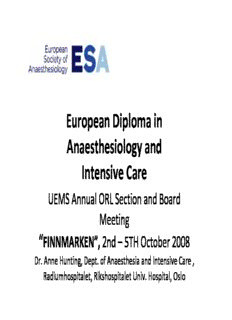
European Diploma in Anaesthesiology and Intensive Care PDF
Preview European Diploma in Anaesthesiology and Intensive Care
European Diploma in Anaesthesiology and Intensive Care UEMS Annual ORL Section and Board Meeting “ FINNMARKEN”, 2nd – 5TH October 2008 Dr. Anne Hunting, Dept. of Anaesthesia and Intensive Care , Radiumhospitalet, Rikshospitalet Univ. Hospital, Oslo Why have a European exam?? Examinations are formidable even for ” the best prepared, for even the greatest fool may ask more than the wisest man can answer” Charles Colton, 1790-1832 1986 goals for the European diploma in anestesiologi • Testing of knowledge. • Positive effect on training programs. • Recognition of merit. • Help in judging applicants trained in other countries. • An advantage in competing for permanent positions. Why a European Exam? • Stimulates learning. • Stimulates study activities in the department and nationally. • Expensive to implement a national specialty exam. • International reputation/recognition. • It makes recruiting new people less chancy. • Among anesthesiologists there is a majority for the exam. EDA1, Oslo 1987 European Diploma Endorsed by the European Board of Anaesthesiology (EBA) of the Union of European Medical Specialties (UEMS) • The existence of a supra-national examination in anaesthesiology provides an incentive for the development of departmental, university, national and European training programmes. • The aim of the examination is to achieve a uniformly high standard of knowledge by anaesthesiologists throughout Europe as judged by an independent Board of Examiners. Beginnings of the EDA exam • 1978: European Academy of Anaesthesiology founded after Invitation letter to national Societies. • April 1984: Examination committee mtg. in London to make the first Part I Exam. • September 1984: Part I (written), Oslo and Strasburg • 1985: Part II (oral), Oslo and Strasburg Harald Breivik, No John Zorab, U.K. European diploma in Anestesiologi and Intensive Care (EDA) Part I Oslo 25 Sept. 1984 Part II 14 June 1985 Strasbourg What were the options of the structure of the exam and how it is conducted today? Paper A Pharmacology Physiology Physics Measurement methods Statistics Paper B Anesthesiology Analgesia Intensive medicine Internal medicine Surgery Other relevant clinical topics
Description: